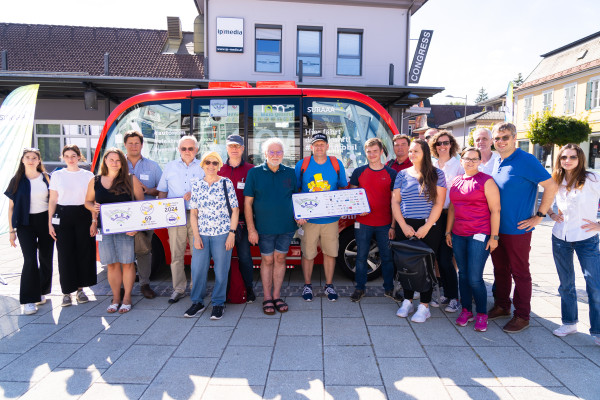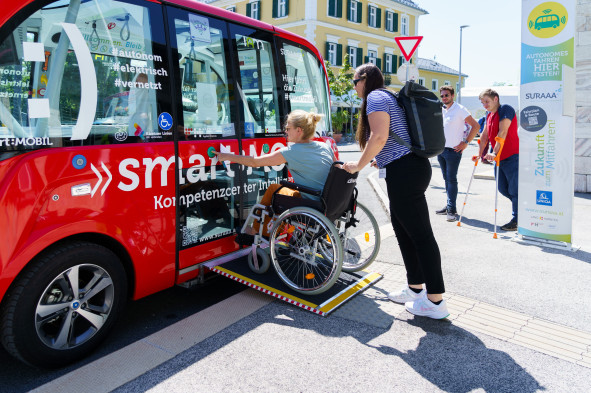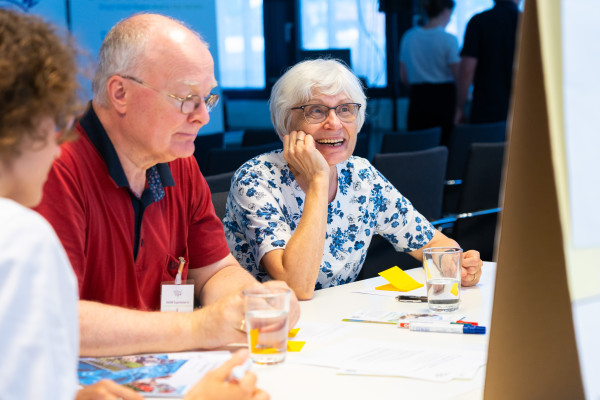Aug 22, 2023
AustriaTech is piloting automated driving in Austria with the Supertester:innen as part of the EU project SHOW. Starting on June 30, 2023, interested individuals can experience the mobility of the future up close in automated shuttles on three test days at the pilot locations in Graz, Pörtschach and Koppl.
The SHOW research project is the largest and most holistic initiative to date in which connected, electrified and automated mobility has ever been tested under real-life conditions worldwide. Automated vehicles are integrated into regular traffic at 20 locations throughout Europe.
The second test day on July 28th took the Supertesters to Pörtschach on Lake Wörthersee. After the introduction at see:PORT, an innovation, thinking, working and co-creation space at Lake Wörthersee, the participants headed towards the shuttle's boarding stop at the train station.
The shuttle has room for eight people and is equipped with comprehensive sensor technology; a laser-based system for navigation in three-dimensional space (LIDAR - "Light Detection and Ranging"), positioning by using satellites and additional odometry on all drive wheels as well as a measurement unit consisting of various sensors (IMU - "Inertial Measurement Unit") for precise navigation of the vehicle.

Once again, the Supertesters completed two rides on the shuttle. The route took them from the Pörtschach train station via the municipal office to the Parkhotel and via the Wahlißwiese/Seeblick directly on the shore of Lake Wörthersee back to the starting stop. Sunshine and high temperatures attracted numerous tourists and locals to the lake, forcing the shuttle to move close to parked cars and pedestrians. The automated vehicle mastered these difficult driving situations on narrow streets with aplomb. The participants described the ride a fluid and very similar to human driving behavior.
The testers saw room for improvement in the abrupt braking processes. In mixed traffic with other road users, it was noticeable that the shuttle handled intersection situations rather more slowly, but overall the driving speed was perceived as appropriate.
As on the first day of testing, the Supertesters were assigned challenges to simulate challenges in automated driving - always assuming that there is no safety driver in the vehicle.
With the simulation drives, the Supertesters can contribute to improving the conditions in the automated shuttle for all user groups. Based on their experiences during the challenges, the participants were asked to identify their needs and expectations in the respective situation, which were then recorded and discussed in the subsequent workshop at see:PORT.
Here are some examples of scenarios that were simulated in the challenges during the second test drive:

At the final workshop, the testers rated the ride experience as extremely positive. The handicapped accessible design of the shuttle was also emphasized in the feedback. At the same time, the Supertesters would like to see more real-time information about vehicle and alternative routes displayed on a central information screen at the departure point. The integration of the timetable and the display of available seats in an app were also valuable suggestions.

The feedback on the challenges, which simulated situational challenges and special user requirements, also provided clues for further optimization of the automated shuttle operation. In the event of an emergency or accidents, for example, a first-aid kit and a connection to the emergency call center should be easily accessible at all times. Also highlighted was potential for improving the driving experience for people with disabilities:
The second test day in Pörtschach am Wörthersee also provided valuable insights for the regular operation of automated shuttles - thanks to the good cooperation of all those involved and the feedback of the committed Supertesters.